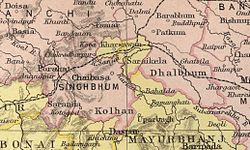| Saraikella State | |||||||
|---|---|---|---|---|---|---|---|
| Princely State of British India | |||||||
Flag | |||||||
 Saraikela State in a 1909 Imperial Gazetteer of India map | |||||||
| Capital | Saraikela | ||||||
| Area | |||||||
• 1892 | 1,163 km2 (449 sq mi) | ||||||
• 1901 | 1,162 km2 (449 sq mi) | ||||||
• 1941 | 1,210 km2 (470 sq mi) | ||||||
| Population | |||||||
• 1872 | 66,347 | ||||||
• 1891 | 93,839 | ||||||
• 1901 | 104,539 | ||||||
• 1941 | 154,844 | ||||||
| History | |||||||
• Established | 1620 | ||||||
| 15 August 1947 | |||||||
| 13 December 1948 | |||||||
• Merged with Bihar | 1 August 1949 | ||||||
| |||||||
| Today part of | Saraikela Kharsawan district, Jharkhand | ||||||
Saraikela State also spelt Seraikela, Saraikella or Seraikella, was a small princely state in India during the British Raj, in what is now the Seraikela-Kharsawan district of the Jharkhand state. [2] [3] Its capital was at Saraikela.
Contents
- History
- Post independence
- Demographics
- Communities
- Rulers
- Kunwars
- Rajas
- Titular Rajas
- See also
- References
- Bibliography
The state had an area of 1163 km2 which yielded an average revenue of Rs. 92,000 in 1901, and was one of the nine Chota Nagpur States, a group of small, non-salute states (minor princely states), under the authority of the governor of Bengal Presidency. [4] The last ruler of the state, Raja Aditya Pratap Singh Deo, signed the merger agreement acceding to the Indian Union on 18 May 1948.

